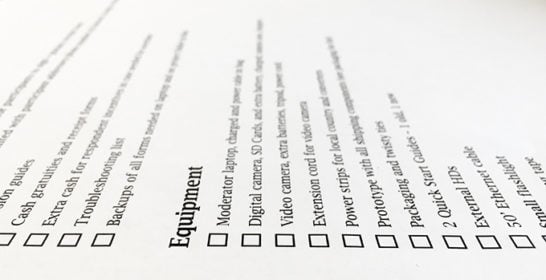Blink researchers conduct different types of field trials across a wide variety of domains and product types. For example, Blink has performed out-of-the-box (OOBE) tests in natural environments around the globe to understand how to best design the initial setup and use of hardware products. During an OOBE test, researchers observe users interacting with packaging, hardware, “quick start” materials, setup software, registration materials, help content, support or firmware update websites, and other physical components. Insights from these field trials allow companies to refine every step of the unboxing and setup process for their products. Blink has performed other field trials evaluating how people use specialized smartphone apps within their natural environments, such as a running app with an integrated running coach or a health provider's app for guiding women through the journey of pregnancy and delivery. Field trials can provide contextual insights that often go unnoticed or cannot be captured in a lab-based study. This allows clients to further refine the user experience of their products and better tailor their products to target markets.
What Are Field Trials?
For those tests you can't run in the lab, field trials offer real-world data. They're often a lot more open-ended than lab testing because the focus is on observing how users interact with a product when left on their own. Anything can pop up during the field trial, which is exactly why we do them.
While many tests focus on hard data, just as vital to a field test is the informal discussions and observations that reveal more than statistical evidence alone. Field tests answer the why and how. UX field testing is a lot like anthropology — we observe your customers in their home environment.
How to Run a Field Trial Survey
Running a field study requires careful planning. Before you arrive on-location, know what you want to study and how. Decide who to bring, what to bring, and who to observe. You'll also need to determine how much interaction the researcher will have with the users.
Decide Which User Testing Tactics to Use
Every field survey needs a custom approach. The product you're testing falls into a specific customer niche or a particular context. So, everything from the target audience and their culture to the location and product itself can impact the design of a field test. Blink UX's field trial services use a tailored strategy for every client. The testing process usually involves a hybrid of many techniques, like:
1. Adaptive interviews: As opposed to structured surveys, adaptive interviews are open-ended for both the customer and the researcher. As you learn more about the user's experience, you refine the questions you ask. You can explore attitudes and learn what jumps out at people using this more informal approach.
2. Customer visits: What issues are specific to the industry, business, or living situation where your customers will use your product? Find out by visiting, observing, and chatting with the customer.
3. Direct observation: When researchers act as flies on the wall, they can see how users interact with a product without prompting. OOBE tests are a type of direct observation. This tactic is useful for design research and allows you to learn about user processes to develop intuitive task flows for future prototypes. It can also reveal user vocabulary. Some examples would be to observe support calls or how the sales team interacts with customers in stores.
4. Ethnographic research: When studying users in a different culture, ethnographic research can uncover the unique cultural situations and needs for the product design. It explores users as members of a group. Use it to learn about their thought processes and social conditions.
When conducting field experiments, many survey tools for user testing allow you to set up different types of questions and responses. However, you likely want to consider other methods besides just surveys for capturing data. We usually recommend filming trials and interviews for more in-depth analysis later.
Gather Actionable Evidence Anywhere
At Blink, we back up everything we do with research. Field studies are a valuable part of this process. We'll design the right experiment for your product and ensure everything runs smoothly in the field. We also take care of all the logistics of coordinating the site, setting up equipment, and wrangling participants. We've even been known to handle some rush-order field tests in just five days.
We'd love to get started! Tell us about your product, so we can tell you about your users.


